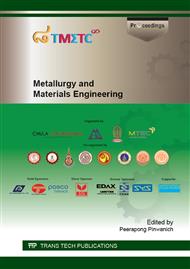p.96
p.101
p.106
p.111
p.120
p.125
p.129
p.135
p.141
Wear of Diamond Grinding Wheel during Low Speed Dressing by Alumina
Abstract:
Diamond grinding wheel is used in high precision grinding process, when work piece has a very high hardness. For a specific grinding interval, the wheel must be properly dressed, in order to remove swarf, sharpen the worn diamond grits, open up new diamond protrusions, and recondition the bond material. Dressing of diamond grinding wheel by alumina dressing tool has been simulated in a pin-on-disk machine in the research. Sharpening of the wheel is indicated by the increase of its roughness value, and surface microstructure with protruding sharp diamond grits. It was found that increasing of sliding distant from 100 to 500 m will increase the roughness of the wheel. The increase of contact load from 10 to 20 N will also increase roughness of the wheel, and the severity of wheel wear, indicated by high values of friction coefficient. A proper dressing of this nickel bonded SD1200 diamond wheel is by sliding against alumina dressing tool for at least 300 m under 10 N load. Sliding velocity has minimal effect to the results. A too large sliding distant and load will cause severe damage to wheel surface, and severe wheel wear, indicated by its large mass loss.
Info:
Periodical:
Pages:
120-124
Citation:
Online since:
July 2015
Keywords:
Price:
Сopyright:
© 2015 Trans Tech Publications Ltd. All Rights Reserved
Share:
Citation:


